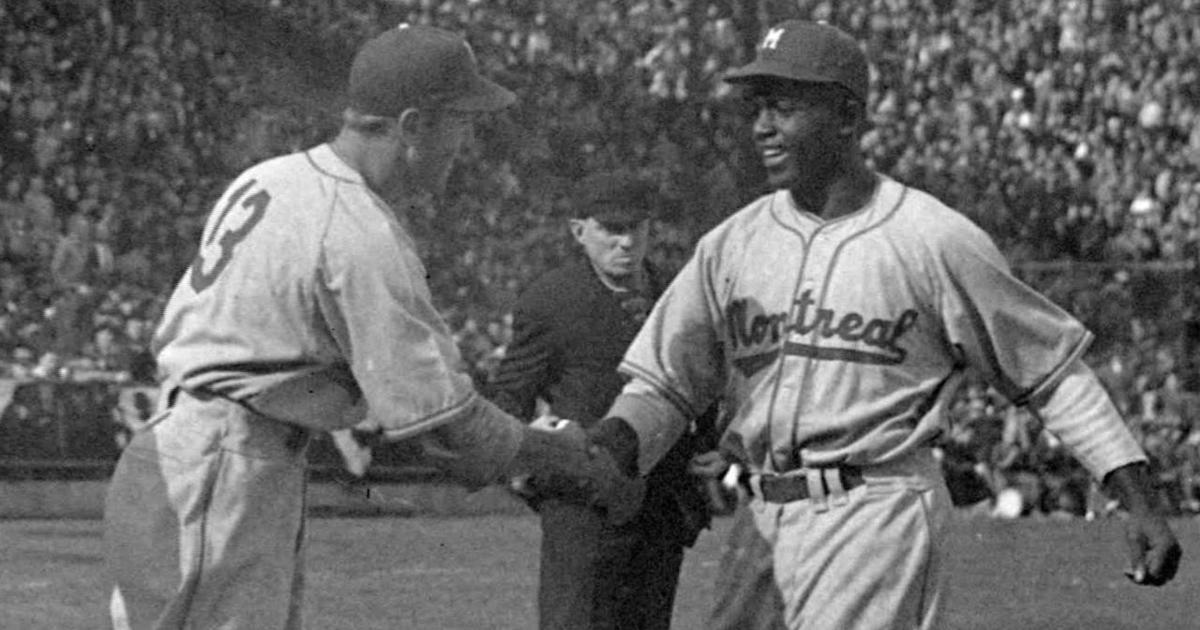Jackie Robinson’s first home run for the Brooklyn Dodgers’ Montreal farm team was a game-changer. What happened next was astonishing.
George “Shotgun” Shuba congratulates Jackie Robinson on his first home run playing for the Brooklyn Dodgers;’ farm team, the Montreal Royals, on April 18, 1946.
CBS News
Correspondent Susan Spencer said, “This has been called the ‘handshake of the century.’ It sounds a little dramatic. Do you think that’s overstating it?”
“Well, we’ve had other important handshakes, internationally and here at home, but this was a harbinger of the civil rights movement to come,” said world-renowned sculptor and baseball fan Marc Mellon.
Robinson, of course, would go on to be a civil rights advocate after finishing his remarkable Hall of Fame baseball career. But first came that handshake: It was April 18, 1946, his debut as the only Black man to play in an all-White league.
“They wanted him to fail,” said Mellon.
So, no surprise, he said, that the other players didn’t even acknowledge Robinson’s first homer, all save the next batter up, George “Shotgun” Shuba.
Mellon said, “If you look at the photographs you can see the pure joy of the moment. He didn’t think Black, White. As George was known to say in later life, ‘I woulda shaken his hand if he was Technicolor!'”
Mellon has studied every minute detail of those photos, as he works on a 7-foot-tall statue of the handshake.
Sculptor Marc Mellon works on his statue of George Shuba and Jackie Robinson.
CBS News
“You have captured both the athleticism and the joy,” said Spencer.
“When you see it outdoors with the sun shining,” Mellon said, “it should just make you smile!”
When it’s finished, the bronze statue will stand in a park in Youngstown, Ohio – George Shuba’s hometown.
Back in 1946, that handshake, for Shuba, would have been something of a risk. “With his teammates, I would think so,” said Herb Washington, a businessman in the Youngstown area. “He may have gotten some jaded looks in terms of, ‘What are you doing?'”
“Why do you think he did it?” Spencer asked. “He didn’t have to do that.”
“I think he did it because it was the right thing to do,” said Washington, who is also a co-chair of the Robinson-Shuba Commemorative Statue Committee.
Spencer asked, “You’ve been involved in a lot of charitable things. What was it particularly about this one that made you want to support it?”
“Jackie Robinson. Period,” he replied.
Washington himself played on the World Series-winning Oakland A’s in 1974. For him, this is personal: “Someone had to be first. Someone had to stand in the gap, and take some unbelievable punishment and cruelty so that the next person may not have to endure as much.”
Spencer asked, “What would life have been like for Jackie Robinson at that time?”
“I can’t even begin to wrap my head around the weight that he must’ve had on his shoulders – not just for himself personally, but all people of color,” Washington replied.
Jackie Robinson’s widow, Rachel, spoke with “CBS Sunday Morning” in 2013. She said there were times when it was very painful for Jackie: “And particularly when you’re being attacked and you can’t respond.
“What we worried about, for instance, pitchers would throw at his head,” said Rachel. “I worried about him getting hurt.”
And with good reason: Robinson routinely received death threats. Rachel said, “I felt like it was us against the world, you know?”
It was in that atmosphere that George Shuba just did what came naturally.
“People have to remember that George didn’t ask to be the batter up,” said Shuba’s son, Mike. “And he did not know Jack was gonna hit a home run. He always taught me as a young kid, if you’re ever put on the spot, just do the right thing and everything’ll work out fine.”
Mike said that handshake photo was such a treasured keepsake, his dad displayed it in the family living room until the day he died.
Spencer said, “This was long before the civil rights movement, before Rosa Parks. In that context, it was, some people might think, a very brave thing to do.”
“Yes. I agree with you, yes,” said Mike. “Other members of the team, some players didn’t even want to bat after Jackie. There were other players, too, that refused to be teammates with Jackie. It’s sad to see that, but George and Jack became friends. And they showed America that America was maturing.”
Spencer asked Washington, “What do you hope this statue says to, say, the father with his kid who walks into the park, two years from now, and looks up and sees it?”
“I hope the father is able to explain to the kid what the statue represents and how, in that child’s lifetime, hopefully racism and bigotry won’t exist,” he replied.
Sculptor Marc Mellon said, “Everything about it is uplifting. There is the dark backstory of, why is this so significant? But it’s America emerging from the war, from a time of segregation, with a realization that we can be better.”
… a realization as simple as reaching out a hand.
CBS News
For more info:
- The Robinson-Shuba Commemorative Statue CommitteeMarc MellonGeorge “Shotgun” Shuba (MLB stats)jackierobinson.com
Story produced by Amiel Weisfogel. Editor: Carol Ross.
